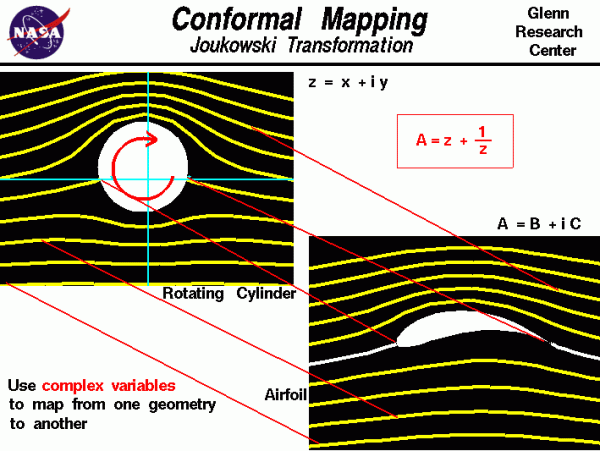Conformal Mapping
Conformal Mapping
Conformal mapping is a mathematical technique used to convert (or map) one mathematical problem and solution into another. It involves the study of complex variables. Complex variables are combinations of real and imaginary numbers, which is taught in secondary schools. The use of complex variables to perform a conformal mapping is taught in college. Under some very restrictive conditions, we can define a complex mapping function that will take every point in one complex plane and map it onto another complex plane. The mapping is represented by the red lines in the figure.
Mapping Function
Many years ago, the Russian mathematician Joukowski developed a mapping function that converts a circular cylinder into a family of airfoil shapes. If points in the cylinder plane are represented by the complex coordinates x for the horizontal and y for the vertical, then every point z is specified by:
z = x + i y
Similarly, in the airfoil plane, the horizontal coordinate is B and the vertical coordinate is C, and every point A is specified by:
A = B + i C
Then Joukowski’s mapping function that relates points in the airfoil plane to points in the cylinder plane is given in the red box:
A = z + 1 / z
The mapping function also converts the entire flow field around the cylinder into the flow field around the airfoil. We know the velocity and pressures in the plane containing the cylinder. The mapping function gives us the velocity and pressures around the airfoil. Knowing the pressure around the airfoil, we can then compute the lift. The computations are difficult to perform by hand, but can be solved quickly on a computer.
Here is a Java simulator which solves for Joukowski’s transformation.
Please note: the simulation below is best viewed on a desktop computer. It may take a few minutes for the simulation to load.
General Instructions
On the left side of the simulator is flow around a cylinder with circulation. On the right side is the mapped geometry and flow for a Joukowski airfoil. You can vary the shape and inclination of the airfoil by using the sliders below the view window on the right, or by backspacing over an input box, typing in your new value and hitting the Enter key on the keyboard. The camber is a measure of the curvature of the airfoil, and the thickness is the maximum height between the upper and lower surface of the airfoil. Angle sets the angle of attack of the airfoil. As you change the airfoil shape, the cylinder moves to a new location and the amount of circulation around the cylinder is changed.
You can also vary conditions in the cylinder plane by using the sliders and input boxes on the left side of the simulator. Radius is the size of the cylinder, X-val is the horizontal location and Y-val is the vertical location of the center of the cylinder. Circulation is related to the strength of the vortex that is located at the center of the cylinder. As part of the Joukowski analysis method, the Kutta condition specifies that the airfoil generates enough circulation to move the rear stagnation point on the airfoil to the trailing edge. Using the menu button at the bottom of the right input panel, you can turn off the Kutta condition to study its effects. The Joukowski transformation has two poles in the cylinder plane where the transformation is undefined. On the blue horizontal axis, the poles occur at x = 1 and x = -1 and are noted by a small “*”. If both poles remain inside the cylinder, a closed body is formed in the airfoil plane. If the surface of the cylinder touches a pole, a sharp edge is formed on the airfoil. If only one pole is inside the cylinder, a very non-physical body is mapped into the airfoil plane. Moving the generating cylinder up and down creates camber in the airfoil. Moving the cylinder left and right changes the thickness distribution on the airfoil.
Joukowski’s transformation and the Kutta condition are used in the the FoilSim computer program. A technical paper describing the details of the method used in FoilSim is also available.

